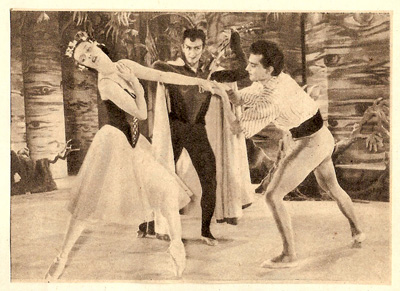| |
Testimonies
& Critics
Mephisto Valse I
In 1951, the French director Ray Ventura filmed “Mephisto Valse” on 16 mm., a ballet upon the music of Franz Liszt, with a libretto and choreography by Serge Lifar. The cast was the original one as represented in Monte-Carlo: Ludmila Tcherina (Marguerite), Edmond Audran (Mephisto) and Wladimir Skouratoff (Faust).
For those who knew about its existence, this version was almost unattainable, due to its antiquity and its format.
It was necessary then to find a passionate english restorer of old films like Charles Doble, a personal friend of Ludmila Tcherina and Michael Powell – the unforgettable director of The Tales of Hoffmann, The Red Shoes, Honeymoon and other wonderful movies that remain as artistic classics from the international filmography.
Through Ashbrittle Film Foundation on the United Kingdom, Mr. Doble has restored several films and it has been thanks to him that we have been able to see and to get a copy, after waiting more than 50 years, of this little precious piece of art.
It has been an unforgettable experience seing Skouratoff dance again, this time on his first years of his professional life – he began in 1945 – and to be able to confirm our first impression of him during his performances in Buenos Aires in 1956 with the Marquis De Cuevas company. And even when in 1951 this extraordinaire dancer had not yet reached its heights, through this film – certainly not made at the best conditions regarding its technicality and other requirements – we can have at least an eyeglance of Skouratoff’s magnificent qualities: an impeccable technique, a great scenic presence, a very intense personality and a great harmony of mouvement and gesture which are hardly found in other dancers.
We are not qualified to make a critical commentary over Lifar’s choreography, which personally does not convince us, because we consider it has been somehow an unfavorable adaptation of the original story, also Faust character being badly drawn precisely on detriment of Skouratoff’s participation, who anyway gets the best of his rôle.
But we want indeed to point out the brief pas de deux of Faust and Marguerite, which have a remarquable beauty and harmony.
We may then consider Mephisto Valse as a valuable document on Dance’s History for the posterity and to the memory of these extraordinaires figures of French dance.
Thanks, Charles Doble and Ashbrittle Film Foundation.
Amalia Contursi
 |
 |
Tcherina,
Audran and Skouratoff in “Mephisto valse”
(1951) |
|
|